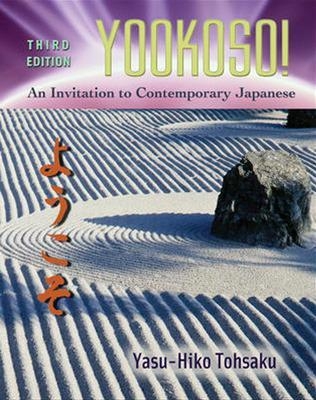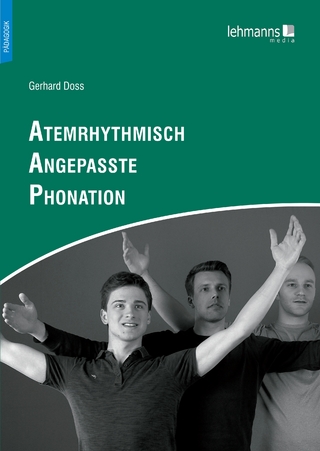
Yookoso! Invitation to Contemporary Japanese Student Edition
McGraw Hill Higher Education (Verlag)
978-0-07-297120-0 (ISBN)
- Titel ist leider vergriffen;
keine Neuauflage - Artikel merken
Yookoso! An Invitation to Contemporary Japanese is the first volume of a two-volume series for beginning Japanese courses. Based on modern principles of second-language acquisition, it was the first beginning Japanese text to integrate the teaching of all four language skills (listening, speaking, reading, and writing) and offer a full complement of ancillary materials. In this text, grammar is treated as a tool for developing the ability to communicate in Japanese, rather than as a focal point. The rich illustration program--including photographs, line drawings, and realia--provides an attractive context for language learning.
Getting StartedPart OneMeeting Others and Introducing YourselfEveryday GreetingsClassroom ExpressionsThe Japanese Writing System (1): IntroductionPart TwoNumbers up to 20Asking and Giving Telephone NumbersAsking and Telling TimeAsking What Something IsThe Japanese Writing System (2): Hiragana (1)Part ThreeTalking About Daily ActivitiesTalking About Future Activities and EventsTalking About Likes and DislikesThe Japanese Writing System (3): Hiragana (2)Part FourTalking About Activities and Events in the PastInviting Someone to Do SomethingTalking About Weekly SchedulesTalking About the WeatherThe Japanese Writing System (4): Katakana (1)Part FiveAsking LocationNumbers from 21 to 10,000Asking About ExistenceAsking About PriceTalking More About Likes and DislikesThe Japanese Writing System (5): Katakana (2)
Introduction to KanjiIntroduction to Yookoso!
Language Notes and Culture Notes are not listed here.
Chapter 1: ClassmatesTopics/VocabularyNationalities and LanguagesPersonal InformationAround CampusStudy Hint: Learning New VocabularyGrammar1. Identification: The Copula desu2. Possessive Particle no3. Personal Pronouns and Demonstratives4. Asking Questions: InterrogativesParticles ha and gaCulture Notesshusshin (Origins)Japanese Universities and CollegesAsking Personal QuestionsReading and WritingReading 1: Huransu-jin no kurasumeetoStudy Hint: Learning KanjiReading 2: penparu o sagashite imasu!KanjiThe Six Types of KanjiSkills PracticeLanguage Functions and Situations Introducing Friends Introducing YourselfListening ComprehensionChapter 2: My TownTopics/Vocabulary Commuting Cities and Neighborhoods Buldings and Places Around TownGrammar5. Adjectives and Adverbs6. Expressing Existence: The Verbs arimasu and imasu7. Indicating Location8. Positional Words9. Numerals and Counters10. Expressing Likes and Dislikes: suki and kiraiSentence-Final yoStudy Hint: Learning GrammarPolite Form Versus Plain FormCulture NotesLong Commuteskooban (Police Boxes)Japanese AddressesReading and WritingReading 1: Buraun-san no apaato no kinjoReading 2: Hayashi-san no hurusatoKanjiSkills PracticeLanguage Functions and Situations Making Communication Work Showing Location on a MapListening ComprehensionChapter 3: Everyday LifeTopics/Vocabulary Schedules Daily Activities Weekends and HolidaysGrammar11. The Basic Structure of Japanese Verbs12. The Nonpast, Polite Form of Verbs13. The Past, Polite Form of Verbs14. Particles Showing Grammatical Relationships15. Making Suggestions: ~mashoo16. Conjoining Nouns: to and yaAdverbs Used in Negative SentencesConnecting Disjunctive SentencesApproximate NumbersCulture NotesPart-Time Jobs for College Studentsnengookokumin no shukujitsu (National Holidays)Reading and WritingReading 1: Buraun-san no nichijooseikatsuReading 2: Buraun-san no shuumatsuKanjiSkills PracticeLanguage Functions and Situations Making a Phone Call Extending an InvitationListening ComprehensionChapter 4: Weather and ClimateTopics/VocabularyWeather ReportsEnjoying the Four SeasonsForecastingGrammar17. Conjugating Adjectives18. Comparatives and Superlatives19. The Past, Plain Forms of Verbs20. Explaining a Reason: ...noda21. The Te-Form of Adjectives and the Copula22. The Te-Form of Verbs23. Adverbs Used with ComparativesLinking Disjunctive Clauses with keredomoConjoining Sequential ActionsCulture Notes°CTypes of RainHow to Write a Letter in JapaneseReading and WritingReading 1: Buraun-san e no tegamiReading 2: Toraberu gaido: Iroha-machi no kikooKanjiSkills PracticeLanguage Functions and Situations Asking Questions About the Japanese Language Asking for Assistance with KanjiListening ComprehensionChapter 5: Hobbies and Leisure ActivitiesTopics/VocabularyHobbies and PastimesSportsFamilyGrammar24. Interrogatives + ka / mo / demo25. Describing Abilities26. Nominalizers: koto and no27. More Uses of the Particle mo28. Potential Form of Verbs29. The Te-Form of Verbs + imasu30. Relative Clauses31. Describing a Change in State: naruNominal Verbska (or)Words Expressing Respect and PolitenessHave You Already Eaten?Some Time ExpressionsCulture Notesgo, shoogi, maajan, pachinko: Japanese GamesWhen You Are PraisedNihon no supootsu: Japanese SportsThe Japanese FamilyReading and WritingReading 1: Sanraizu Karuchaa Sentaa no oshiraseReading 2: Gakusee to sarariiman no yoka choosaKanjiSkills PracticeLanguage Functions and Situations Responding to Compliments Introducing a Family MemberListening ComprehensionChapter 6: FoodTopics/VocabularyFoods and BeveragesFlavors and TastesCooking TermsGrammar32. Expressing Experience: The Ta-Form of Verbs + koto ga aru33. Expressing a Desire: hoshii, hoshigaru, ~tai, and ...tagaru34. Expressing an Opinion: ...to omou35. ~sugiru36. Quoting Speech: ...to iu37. Expressing Intention: tsumori and the Volitional Form of Verbs38. The Te-Form of Verbs + miru, shimau, iku, and kuru39. Expressing Simultaneous Actions: ~nagara~garusooQuote Marker toStudy Hint: How to Remember Verb Conjugationsmoo and madaCulture NotesochaWhat Do Japanese Eat?Reading and WritingReading 1: Baikingu ryoori ‘Murasaki’Reading 2: Anata no shokuji chekkuKanjiSkills PracticeLanguage Functions and Situations Asking and Expressing Opinions At a RestaurantListening ComprehensionChapter 7: ShoppingTopics/VocabularyShops and StoresShoppingClothesGrammar40. When Something Happens: Temporal Clauses Ending in toki41. Indefinite Pronoun no42. Making If-Then Statements: The tara Conditonal43. Going Somewhere with a Purpose: Using the Particle ni to Express Purpose44. Reporting Hearsay: ...sooda45. Saying Whether or Not Something Is True: ...kadooka46. Giving Reasons with ...shi, ...shidake~yasui, ~nikuiCulture Notesiro (Colors)Handling Japanese MoneyMetric SystemReading and WritingReading 1: ‘San Roodo’ gurando oopuningu seeruReading 2: mai fasshionKanjiSkills PracticeLanguage Functions and Situations Shopping Saying Whether Two Things Are the Same or DifferentListening ComprehensionAppendices1. Verb Conjugation2. Adjective and Copula Conjugation3. Numbers4. Counters5. Time, Days, Months, and Years6. Ko-so-a-do Words7. Japanese Accent8. Kanji List
Japanese-English GlossaryEnglish-Japanese GlossaryIndex
| Verlagsort | London |
|---|---|
| Sprache | englisch |
| Maße | 208 x 259 mm |
| Gewicht | 1225 g |
| Themenwelt | Schulbuch / Wörterbuch ► Erwachsenenbildung |
| Schulbuch / Wörterbuch ► Wörterbuch / Fremdsprachen | |
| Geisteswissenschaften ► Sprach- / Literaturwissenschaft ► Sprachwissenschaft | |
| ISBN-10 | 0-07-297120-7 / 0072971207 |
| ISBN-13 | 978-0-07-297120-0 / 9780072971200 |
| Zustand | Neuware |
| Haben Sie eine Frage zum Produkt? |
aus dem Bereich


